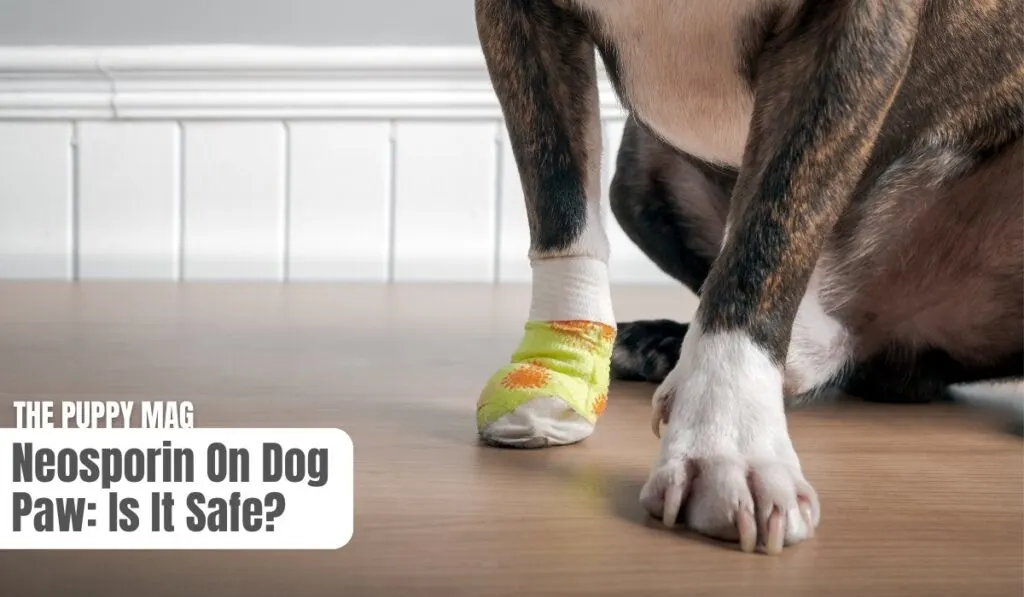Neosporin is an effective antibiotic cream for humans, but can it help our dogs too?
If your pup has incurred a minor scrape or nick on their paw, would it be appropriate to use Neosporin? This article will provide all the answers you’re looking for.
While some veterinarians will recommend a small amount of Neosporin in certain situations, many others will not. And that’s likely due to one of the ingredients that we’ll explain below.

What Exactly is Neosporin?
Neosporin is a triple-antibiotic salve offering protection against infection for a day, soothes itchiness, and shields against scarring. It is typically employed for minor injuries and abrasions.
This extremely popular antibiotic salve is readily available to buy without a prescription globally.
When we inspect the ingredients, we begin to comprehend why it might not be prudent to apply it to your dog’s paw (or any other area).
It primarily consists of three components, thereby earning the title “triple” antibiotic salve.
- Neomycin Sulfate
- Polymyxin B Sulfate
- Bacitracin Zinc
Dr. Rachel Barrack, a licensed veterinarian proficient in veterinary acupuncture and Chinese herbology at Animal Acupuncture, clarifies that Bacitracin and Polymyxin B are considered safe for animal application.
👉 However, Neomycin has been associated with hearing impairment. This was initially observed with intravenous administration. It’s recommended not to use neomycin topically without engaging your local veterinarian’s guidance.
Related article: Is Polysporin Appropriate for Dogs?
Is Neosporin Safe for My Dog?
Numerous veterinarians strongly advise using Neosporin sparingly on your dog. It should be restricted to minor nicks and abrasions.
For wounds that are more severe or deep, seek professional medical assistance.
Given that Neosporin is a topical medication, there’s always a possibility that your dog might exhibit an allergic reaction once applied to his skin.
It is best to conduct a patch test on your dog initially, even before an actual wound requires treatment.
Find a small section of skin away from the face and apply a little Neosporin. Monitor the area for any signs of discomfort, irritation, redness, or rash.
If your dog exhibits no reaction, you can confidently use Neosporin with minimal worry. But again, ensure your dog cannot reach it with their mouth. The last thing you want is your dog to ingest it.
And stick to a standard strength version.
Disclaimer: We advise speaking to your veterinarian before giving your dog any medicine/cream that’s not originally made for use on dogs.
👉 Polysporin might be more appropriate.
Can You Apply Neosporin on a Dog’s Paw?
Our furry companions are prone to acquiring a few scratches and abrasions in their adventures. We usually discover the most injuries on their paws and legs.
The primary problem with applying Neosporin on a dog’s paws is the temptation for them to lick it off. It’s not only potentially harmful for your dog to ingest Neosporin, but it also negates its effect if licked off.
You may consider bandaging the paw post-application, but for many dogs, this only heightens the desire to lick and chew.
If you’re confident that your dog will leave his injured paw alone, proceed without much worry. Always observe your dog post-Neosporin application and be ready to stop him if he starts to nibble or lick the area.
Dog Has White Bumps on Paw Pad: Why & When To Be Concerned
Eyes, Ears, and Mouth
Never apply Neosporin around the eyes, ears, and mouth. Ingestion or exposure of Neosporin might cause your dog to become ill. Utilize Neosporin strictly on areas away from these sensitive spots.
Remember that your dog will likely try to lick the Neosporin from his wound. This not only negates its purpose but could potentially make your dog ill.
Alternatives to Neosporin
Given that Neosporin wasn’t specifically designed for dogs, it’s understandable if you’d prefer an alternative.
If your furry pal returns to you with a fresh wound, reach for Vaseline (petroleum jelly) instead of Neosporin.
Stephanie Flansburg Cruz, a practicing veterinary physician, asserts that it’s safe to use Vaseline on dogs. While it’s not toxic, try to prevent your dog from consuming or licking it.
It isn’t always necessary to use a product; merely keep the minor cut or abrasion clean by using his typical natural ingredient dog shampoo.
I highly suggest a natural shampoo to sidestep harmful chemicals commonly present in regular pet shampoo.
Trending: Redness Between Dog Toes: Why & How To Help at Home
Basic Wound Care for Your Dog
Regardless of the circumstances in which your dog gets a minor cut or scrape, there are methods to address it quickly and safely.
If it’s a minor issue, you may not need to rush to the local vet.
Typically, a minor cut or scrape is no more than an inch long, superficial, and relatively clean-edged.
If your dog has any wound or scratch larger than this, or with excessive bleeding, immediately seek your veterinarian’s help.
If it is minor, you can handle this effectively at home. All you need is a small cloth and some warm water to gently cleanse the wound and carefully remove any dirt.
Once the wound is clean, apply an antibiotic ointment (Neosporin) or, if you prefer not to use this, some petroleum jelly will also suffice and will not harm your dog.
Summary
Let’s distill the contents of this article. Is it possible to apply Neosporin on a dog’s paw?
Yes, Neosporin can be applied on your dog’s paw, given the wound is minor and you prevent your dog from licking or consuming any Neosporin.
It’s non-toxic to dogs, but could cause an allergic reaction for some. First test it by conducting a small patch test on the skin.
I hope you found this informative! Please comment below if you have any experiences with treating minor cuts on your dog. We’d appreciate your tips and advice.
